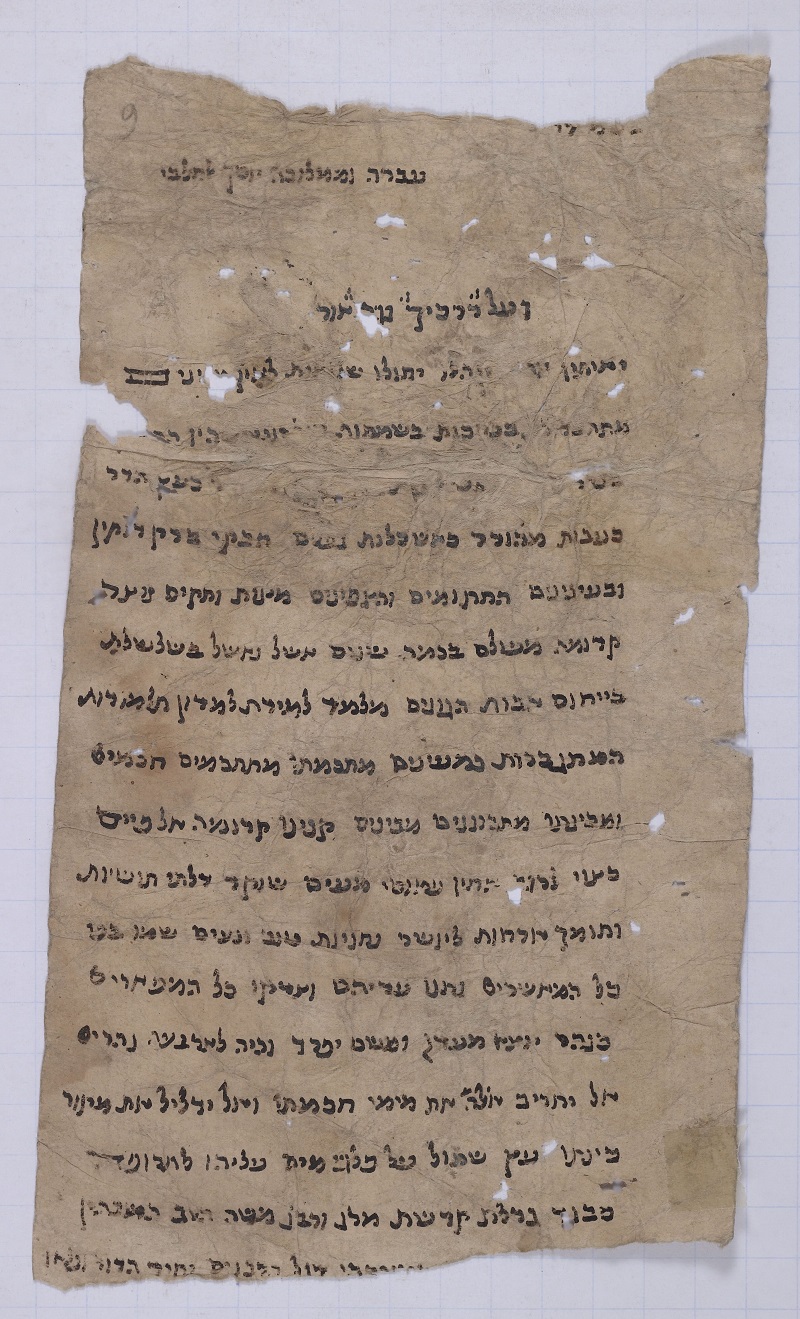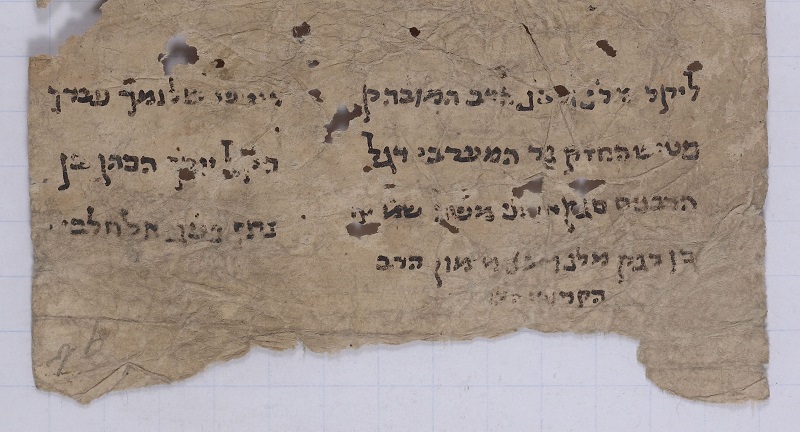Addressing the Rambam: JTS ENA 4020.56
The identification of autograph manuscripts of Moses Maimonides has long been a focus of Genizah research. Perhaps the most famous autograph in the Cambridge Genizah, T-S 12.192, the Rambam’s short letter to al-Šayḵ al-Ṯiqa on behalf of new immigrants to Egypt, Isaac al-Darʿī and his son, was first published by Richard Gottheil in 1936. Its significance lies in the fact that the Rambam signed it with his full name, Moses son of the scholar Maymūn, whereas much other autograph material is either unsigned (e.g., his letter to a judge, T-S AS 149.89) or, as is often the case with his responsa, simply marked with וכתב משה, ‘written by Moses’ (e.g., T-S AS 111.164).
While the scarce autograph writings give us insight into Maimonides’ writing process (through his draft works and fair copies), his communal responsibilities (notes and circulars he wrote) and his daily life (through letters), there is a wealth of material available that fills out that picture with a larger sense of where he stood in the Jewish community of Egypt, his reputation in the Jewish world beyond, and the attitude towards him of his contemporaries. Scholars have been finding letters to and about Maimonides for many years – the late Joel Kraemer’s ‘Six unpublished Maimonides letters from the Cairo Genizah’ (1990) is a good example of some of the riches available – but there has not been a systematic search for such ‘secondary’ texts. S. D. Goitein clearly saw this letter, as he refers to it in his card index, but he did not include it in his index of Maimonides. That such texts remain to be read shows that there is still much potential in surveying the Genizah collections worldwide for documents relating to the wider circle of Maimonides and his world.
The following document is a good, but sadly curtailed, example of the type of material that probably lies unidentified in the various Genizah collections. It is the opening of a long Hebrew letter (at least the opening is in Hebrew; the business of the letter itself might well have been in Judaeo-Arabic), from Joseph b. Nathan al-Ḥalabī, from Aleppo. The ornate opening addresses a very distinguished man, an authority in his community and a teacher of renown. The great length of the opening salutations delays the appearance of the recipient’s name until line 20, and only the first name, Moses, is given before the manuscript breaks off. The address on verso clearly states that it is addressed to Moses son of Maymūn, however. The Rambam’s connection with Aleppo is well known: his most beloved student, Joseph b. Judah, for whom Maimonides wrote the ‘Guide for the Perplexed’, was also from Aleppo. It seems he had a number of followers from that town, and we also have a legal query sent to him from Aleppo (Blau 1960: 515–516 [§269]). The present correspondent, Joseph al-Ḥalabī, is not yet known from other sources.
This letter was discovered among the documents of the Jewish Theological Seminary’s ENA Collection, currently stored in Princeton University, when Amir Ashur was recently working on a short project there. It is surprising that it had not previously drawn the eyes of scholars, as the address identifying the Rambam as the recipient is clear. The particular combination of grandiloquent titles is also a major hint, if not specifically unique to the Rambam, that a Nagid is being addressed: ‘the Distinguished Rav, the Mighty Hammer, the Western Lamp, Banner of the Rabbanites’ are all titles associated with the Negidut in Egypt (and Spain) for at least a century before Maimonides was granted them.[1] The elaborate and imaginative opening, however, draws on a wide range of biblical verses and fulsomely praises Maimonides’ status, erudition, and position in the chain of Jewish tradition. While the formulaic repetition, in the correct order, of bombastic titles would not have looked out of place in a letter written a century before, to the Nagid Mevorakh b. Saʿadya, who had a fixed order to his impressive array of epithets (Cohen 1980: 264–266), the letter’s artful stress on the recipient’s intellectual accomplishments, his expertise as a teacher and his role as a guardian of halakha, mark this out as addressing not just a man of great status in his community, but a man of renowned intellect, of spiritual status and scholarly attainment.[2]

Jewish Theological Seminary ENA 4020.56 recto, a letter by Joseph b. Nathan.
Image provided by the Library of the Jewish Theological Seminary.
1. ב[ש]מ׳ רח[מ׳]
2. עבדה וממלוכה יוסף אלחלבי
3. ועל דרכיך נגה אור
4. יאומן צד[יק] קהלו יחולו שלומות לאין מ[נ]ינים
5. מתחברות בברכות בשמחות .... היו ה[...]
6. [.............................................] כעץ הדר
7. כעבות מהודר כאשכלות גפנים הבקי בדקדוקין
8. ובעינינים החתומים והצפונים מצות וחקים נוצר
9. קדומה מעולם בכמה שנים אשל נאשל בשלשלת
10. בייחוס אבות הגונים מלמד למידת למדון תלמודות
11. המתגברות כמעינים מחכמתו מתחכמים חכמים
12. ומבינתו מתבוננים מבינים קנינו קדומה אלפיים
13. כצוי לרוב אחיו עמוסי מעים שוקד דלתי תושיות
14. ותומך ארחות ליושר נחויות טוב ונעים שמו בפי
15. כל המאשרים נתנו עדיהם וצדקו כל המפארים
16. כנהר יוצא מעדן ומשם יפרד והיה לארבעה נהרים
17. אל יחריב אלה׳ את מימי חכמתו ואל ידליל את מקור
18. בינתו עץ שתול על פלגי מים עליהו לתרופה
19. כבוד גדלת קדשת מרנ׳ ורבנ׳ משה הרב המובהק
20. נר המ]ערבי דגל הרבנים יחיד הדור ופלאו...]
21. [...]

JTS ENA 4020.56, a detail of the verso showing the address.
Image provided by the Library of the Jewish Theological Seminary.
The address
1. ליקר מרנ׳ ורבנ׳ הרב המובהק דורש שלומך עבדך
2. פטיש החזק נר המערבי דגל הקל יוסף הכהן בן
3. הרבנים כגק אדוני משה שמ׳ צו׳ נתן נע׳׳ג אלחלבי
4. בן כגק מרנ׳ ורבנ׳ מימון הרב
5. הקדוש נע׳׳ג
1. In Your name O Merciful One
2. His servant and his slave Joseph al-Ḥalabī
3. ‘And the light shall shine upon your ways’ (Job 22:29)
4. May he be declared the righteous one of his community, may good things whirl about without number
5. joining up with blessings and boons …
6. … like a goodly tree,
7. like splendid foliage, like clusters of vines. An expert in fine detail
8. and in hidden and recondite matters, a guardian of commandments and laws
9. older than the world by many years, a tamarisk firmly rooted in the chain of
10. tradition of worthy ancestors, a teacher at the pinnacle of instruction, of knowledge
11. that grows mighty like springs. From his wisdom, the wise become wiser,
12. and from his insight, the discerning gain understanding of His two-thousand-year-old creation.
13. Like the one ‘accepted of the multitude of his brethren’, born from the belly of the one who watches at the doors of sound wisdom
14. and he who upholds paths for guiding the righteous. Good and pleasant is his name in the mouths of
15. all who lead the way – they have presented their witnesses – and all those who glorify his righteousness.
16. Like a river running down from Eden, thereafter splitting up to become four rivers,
17. let God not cause the waters of his wisdom to dry up, nor bring low the source of
18. his insight. A tree planted by the channels of the rivers, his leaves be for balm.
19. The honourable, great, holy, our master and our teacher Moses, the Distinguished Rav,
20. [the Mighty Hammer,] the Western Lamp, Banner of the Rabbanites, Unique One of the Generation and its Wonder,…
The address (verso):
Right
1. To our dear master and our teacher, the Distinguished Rav
2. The Mighty Hammer, the Western Lamp, Banner of
3. the Rabbanites, the h[onourable], g[reat], h[oly], our master and our teacher Moses – his Rock preserve him –
4. son of the h[onourable], g[reat], h[oly], our master and our teacher Maymūn the Holy Rav –
5. his rest is in the Garden of Eden.
Left
1. Seeker of your wellbeing, your simple servant
2. Joseph ha-Kohen son of
3. Nathan – his rest is in the Garden of Eden – al-Ḥalabī.
Notes on the translation:
Main text
1. In full, בשמך רחמנא.
6. ‘Like a goodly tree’ is taken from Leviticus 23:40.
7. ‘Like splendid foliage’ is from Leviticus 23:40. ‘Like clusters of vines’ is from Song of Songs 7:8.
8–9. ‘Laws older than the world by many years’ refers to the Torah. Proverbs 8:23 is one commonly used biblical proof that the Torah is older than the world.
13. The writer probably meant to write כרצוי, but accidentally wrote כצוי. The phrase ‘accepted of the multitude of his brethren’ is from Esther 10:3, where it describes the biblical Mordechai. Maimonides bore the title ‘Mordechai of his age’, as the twelfth-century Nagid Samuel b. Ḥananya had before him (Cohen 1980: 12, 280).
13. ‘Born from the belly of the one who watches at the doors of sound wisdom’ combines Proverbs 8:34 and 8:14.
15. ‘They have presented their witnesses’ borrows from Isaiah 43:9.
16. ‘Four rivers’ is from Genesis 2:10.
18. ‘A tree planted by the channels of the rivers’ borrows from Psalms 1:3.
19. In full, מרנא ורבנא.
19–20. ‘The Distinguished Rav, the Mighty Hammer, the Western Lamp, Banner of the Rabbanites’ etc were all Maimonides’ titles, many of them having been inherited from previous Nagids, such as Mevorakh b. Saʿadya in the eleventh–early twelfth centuries (cf. Cohen 1980: 264–266). The ‘Western Lamp’ is a reference to the lamps that burned in the Temple, see B.T. Tamid 33a (and M. Tamid 3:9), and was earlier used of Samuel ha-Nagid (Samuel ibn Naḡrilla), lauding him as ‘the Lamp of the West, i.e. the great light of the Maghreb (Cohen 1967: 282).
Address
Right
3. The abbreviation כג׳׳ק is the standard epistolary mode of address in the Classical Genizah period, כבוד גדולת קדושת, three construct nouns.
5. The abbreviation נע׳׳ג is נוחו עדן גן, one of a number of common post-mortem blessings.
Amir Ashur is grateful to the Fritz Thyssen Stiftung for supporting his work on Moses Maimonides and his circle in the Cairo Genizah.
Bibliography
Blau, J. (1960). R. Moses b. Maimon: Responsa (vol. 2).
Cohen, G. (1967). A Critical Edition with a Translation and Notes of The Book of Tradition (Sefer ha-Qabbalah) by Abraham Ibn Daud.
Cohen, M. (1980). Jewish self-government in medieval Egypt: the origins of the office of head of the Jews, ca. 1065-1126.
Gottheil, R. (1936). ‘Some responsa of Maimonides’, in B. Schindler & A. Marmorstein (eds), Gaster anniversary volume: Occident and Orient: being studies in Semitic philology and literature, Jewish history and philosophy and folklore in the widest sense: in honour of Haham Dr. M. Gaster's 80th birthday: 173–180.
Kraemer, J. (1990). ‘Six unpublished Maimonides letters from the Cairo Geniza’, Maimonidean Studies 2: 60–94.
Kraemer, J. (2008). Maimonides: the life and world of one of civilisation’s greatest minds.
Footnotes
[1] Moses Maimonides criticised certain people in his own day for having meaningless, high-sounding titles, connected to defunct institutions, such as the Palestinian Academy (Kraemer 2008: 227). These were quite different from his titles, which he had earned through public service and which denoted the positions he held in the community.
[2] This is not to belittle Mevorakh’s own attainments in the field of jurisprudence and the writing of responsa, but there’s a clear winner when one compares the author of ‘The Guide’, the Commentary on the Mishnah and the Mishneh Torah, with the man who trained his parrot to recite the Šemaʿ (on which see Cohen 1980: 120).
Cite this article
Ashur, A., & Outhwaite, B. (2020). Addressing the Rambam: JTS ENA 4020.56. [Genizah Research Unit, Fragment of the Month, March 2020 ]. https://doi.org/10.17863/CAM.65167
If you enjoyed this Fragment of the Month, you can find others here.
Contact us: genizah@lib.cam.ac.uk
The images in this articles are from the Jewish Theological Seminary and used with kind permission. Other manuscripts mentioned are in the Cambridge Digital Library. To see these and other items follow the links in this article or visit: https://cudl.lib.cam.ac.uk/
